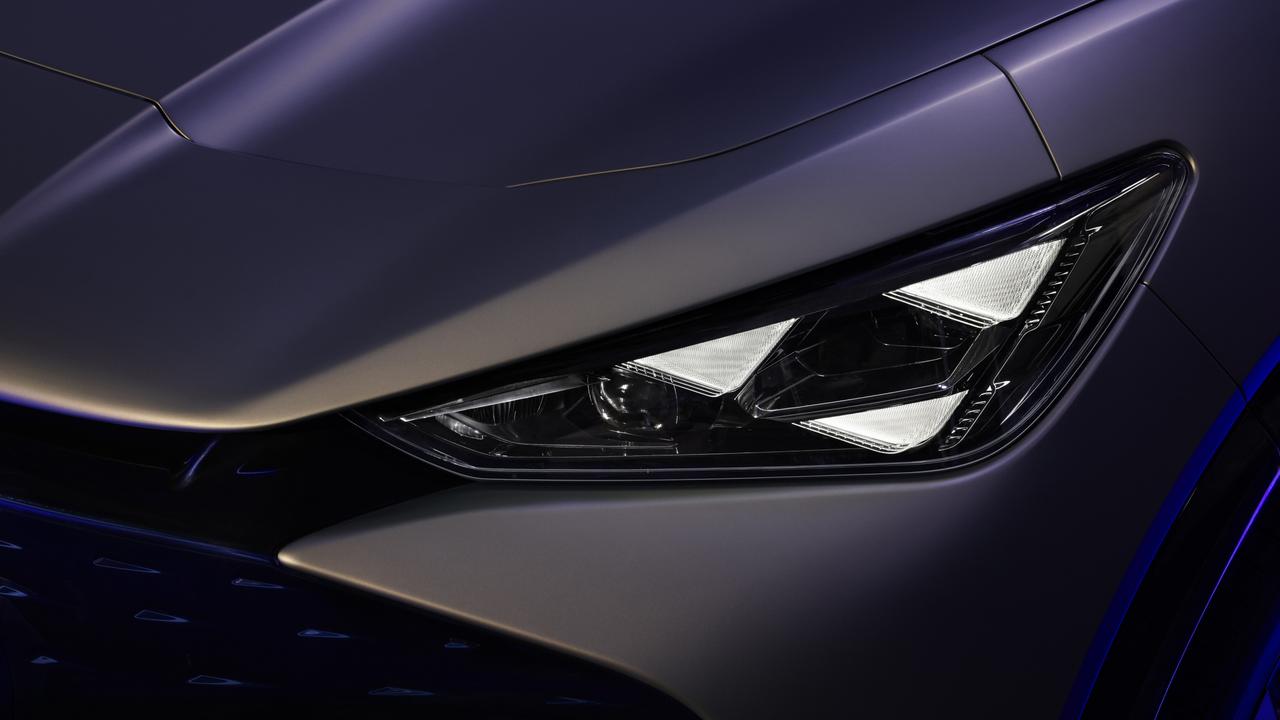Tesla Model 3 vs. Toyota Camry Hybrid
The electric Tesla Model 3 and hybrid-powered Toyota Camry represent two of the most popular sedans on Australian roads. Which one is best?

New Cars
Don't miss out on the headlines from New Cars. Followed categories will be added to My News.
From cab ranks to suburban garages it wasn’t long ago that the Ford Falcon and Holden Commodore were the favoured rides for so many Aussies. These days it’s the Toyota Camry and Tesla Model 3 flying the sedan flag and keeping ride share operators buzzing around town.
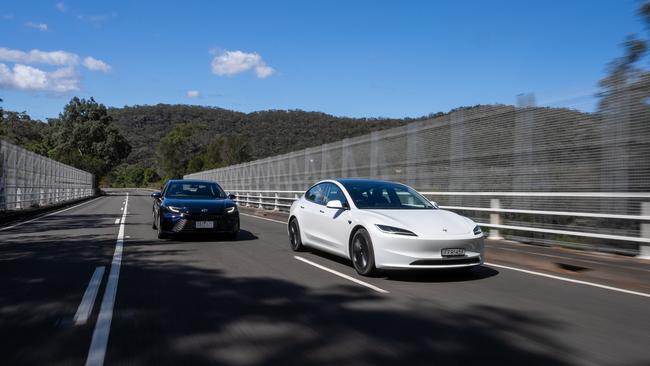
TESLA MODEL 3
It’s easy to see why the Tesla is a popular car. At about $60,000 drive-away, the all-electric four-door packs plenty in, including tri-zone ventilation, ambient lighting, panoramic sunroof, faux leather, dual wireless phone chargers, power opening boot, heated rear seats and heated, ventilated and electrically adjustable front seats.
The Tesla also gets a vibrant 15-inch infotainment screen packed with surprise-and-delight goodies and an 8-inch screen in the rear. Each can stream video and play games.
But the Tesla’s secret weapon – as with all sub-$90K EVs – is being able to leverage the fringe benefits tax exemption. For those taking out a novated lease it makes the Model 3 cheaper than the Camry.
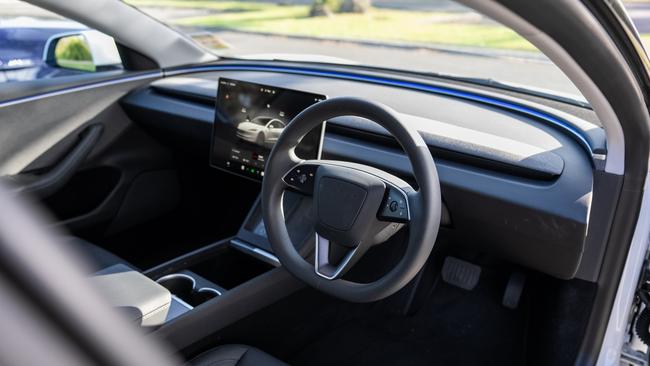
The Tesla also delivers on space. With no engine and gearbox it provides ample room for occupants, although back seat knee room is only average and under-seat foot space is tight. But it has a big boot in the back and additional space under the bonnet.
The Tesla is powered by a 194kW electric motor. Press the throttle and it surges with intent, the effortless urge of an electric motor making light work of city traffic.
The latest Model 3, introduced late in 2023, has fancy frequency-responsive shock absorbers can adjust the damping force depending on the size and sharpness of the bump. The result is a car that lopes over big bumps smoothly, cosseting those inside. It’s also impressively quiet, keeping wind and road noise at bay.
Powering the rear wheels means the Model 3 easily harnesses its power, too, jumping assertively out of bends. Yet the Tesla also feels precise, fun and predictable to drive.
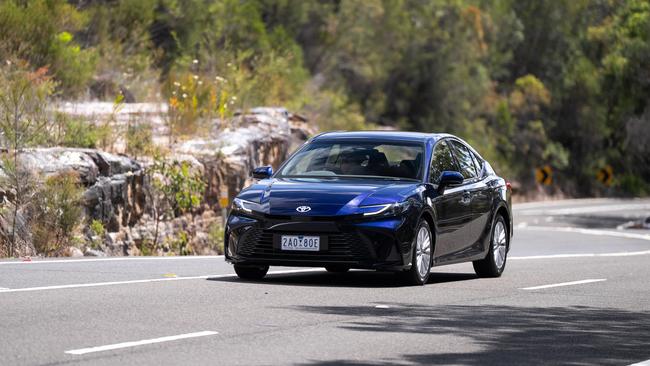
TOYOTA CAMRY
Camrys have long had a reputation for being conservative and the latest iteration lives up to the hype, albeit now with hybrid power as standard.
The cabin is a sea of grey and sparsely equipped. The central infotainment screen is only 8 inches in diameter and the fanciest feature is dual-zone ventilation. There’s also an SOS button for calling emergency services.
It at least gets Apple CarPlay and Android Auto, though no wireless charging. And the Camry is comparatively cheap, at about $45,000 drive-away in entry-level Ascent guise tested here.
The Toyota’s big win is its rear accommodation. Headroom is similar to the Tesla, but there’s loads more legroom for adults.
The Camry’s 524-litre boot is also respectable, although with the back seats folded it’s a narrow aperture to squeeze in the latest Bunnings haul in.
Beneath the skin is a 2.5-litre four-cylinder and a 100kW electric motor, the two combining to make 170kW.

It also helps deliver an impressively low fuel figure of 4.0 litres per 100km. We used about 4.5L/100km, but for such a big car the Camry is frugal.
That said, for all but ultra rapid charging on road trips – where charging costs are high – the Tesla will be cheaper to keep moving. That hybrid system pulls strongly from a standstill, albeit without the immediacy of the Tesla. Driving the front wheels means it can slip as it tries to get the power down.
Ours also had noticeable wind noise and a droning engine.
Through corners the Camry is unflustered but uninspiring. It’s built for comfort over pace. It feels nose heavy and there’s a lifelessness to the steering, which is predictable and relaxed. The lack of sharpness is countered by a cushiness that makes the Camry a comfy cruiser.
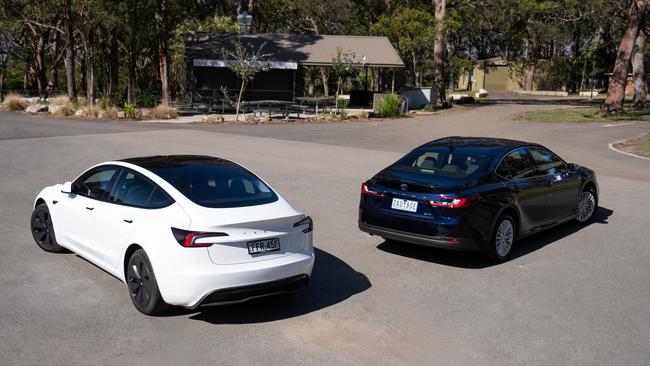
VERDICT
If you want the best car make a beeline for the Tesla. While electric may not suit everyone, access to Tesla’s vast charging network makes it easier than other EVs. And the Model 3 gets a lot right, from value and cabin space to comfort and performance. Sure, it’s $15K more than the Toyota but it’s easy to see where the money has gone. And those taking out a novated lease can leverage the FBT exemption to make the EV cheaper than its hybrid competitor. The Toyota fights back with more legroom in the rear and a plush ride. Combined with a peerless reputation for reliability it makes the Camry a safe proposition. But if you’re prepared to live a little the Tesla makes more sense.

TESLA MODEL 3
Price: About $60,000 drive-away
Warranty/servicing: 4 years/80,000km, servicing not supplied, but assume about $1200 for 5 years/70,000km
Safety: 6 airbags, autonomous emergency braking, lane departure warning, lane keep assist, driver monitoring, speed sign recognition, blind spot warning
Engine: Single electric motor driving the rear wheels, 194kW/340Nm
Thirst: 13.2kWh/100km, 513km range (WLTP)
Boot: 594L boot, 88L frunk
Spare: None

TOYOTA CAMRY HYBRID
Price: About $45,000 drive-away
Warranty/servicing: 5 years/unlimited km, $1275 for 5 years/75,000km
Safety: 8 airbags, SOS button/emergency call, autonomous emergency braking, lane departure warning, lane keep assist, driver monitoring, speed sign recognition, blind spot warning, rear cross traffic alert
Engine: 2.5-litre 4-cylinder, 170kW/221Nm
Thirst: 4.0L/100km (premium unleaded)
Boot: 524L
Spare: Space saver
Originally published as Tesla Model 3 vs. Toyota Camry Hybrid

